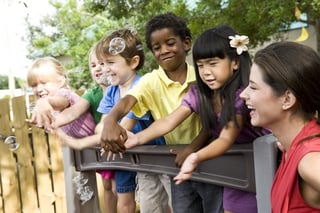How Understanding Differences Helps Build Leadership Skills in Preschoolers
With 7.4 billion people on earth, we are each different, improbable as that sounds. We grown-ups know we are all different, of course, because as adults we have met thousands out of those billions; no two have been alike. Our preschoolers, however, have met very few people unlike themselves. Any opportunity to highlight and appreciate differences in others can help your preschooler to become a leader not just in school, but in life.
 Identifying Differences
Identifying Differences
Preschoolers tend not to notice other people, young or old. They may have a hard time identifying what Grandma looks like, for example. Instinctively, they think primarily about themselves.
The experts at Scholastic identify common traits of three- and four-year-olds:
- They can respond to a friend's distress with simple soothing gestures
- Three-year-olds cannot put themselves in another person’s shoes
- Four-year-olds can see simple situations from another’s perspective
An early start on empathy, socialization, and taking another person’s perspective can help your child advance in a group. This is the beginning of diplomacy, tact, and compassion. This is leadership.
Teamwork
When your daughter becomes aware that other children are not cookie-cutter copies of her, she can start to work with them as team members. Parallel play subtly shifts to cooperative play. Teams complete more work and play than isolated children. Group activities become far more fun and immersive.
Entrepreneur magazine emphasizes teamwork by recommending, as one of 15 leadership activities, that children join groups based on interest:
- Scouts
- Sports teams
- Art clubs
- 4H
- Band
- Children's Theatre
Who is Different?
Differences may be tough to identify for your preschool son or daughter. Help your children to see, appreciate and value differences in all ways:
- Skin color
- Favorite foods
- Hair texture and color
- Age
- Family activities
- Special holidays and meals
Simple things, like left-handedness and right-handedness, may elude preschoolers. You can try this leadership-boosting game—from Penn State’s Extension Office—at home or at a group event:
Children sit in a circle; select one child to go first. The first child points to someone in the circle who shares a characteristic such as hair color. That child finds someone with a different characteristic, such as shirt color, that is shared. Help them discover everyone has differences and everyone also has things that are the same.
How do you help your preschooler appreciate differences in other people? Kids Konnect asks you to share your insights in the space below.
